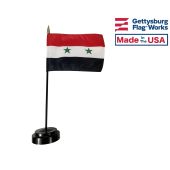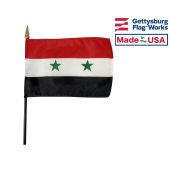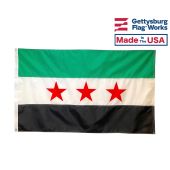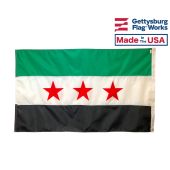Buy Syria Flags
- Syria Stick Flag (Old Design) - 4x6"Special Price $1.00 Regular Price $3.99
-
Flag of Syria
The first flag of Syria was born during the Arab Revolt against the rule of the Ottoman Empire, and most of the flags that have been used since then have shown a clear influence from that period. The origins of the Syria flag mean that it has a great deal in common with many other flags that are in use in the Arab world, which allows it to serve as a symbol of unity and solidarity with the rest of the Arab nations in addition to serving as a symbol of the Syrian people and their nation.
- Capital of Syria: Damascus
- Area of Syria: 184,050 sq. km
- Languages used in Syria: Arabic (official), Kurdish, Armenian, Aramaic, Circassian, French, English
- Religions in Syria: Sunni Muslim, Alawite, Druze, other Muslim sects, Christian, Jewish
Colors and Symbolism of the Syria Flag
The flag of Syria is made up of three horizontal stripes of red, white, and black with a pair of green stars in the white stripe. The flag's design is based on that of the Pan-Arab movement, which used the same set of colors to represent the major Caliphates in Arab history, but the modern Syria flag attributes new meanings to the colors. The red stripe stands for the nation's struggle for independence from foreign rule, the white stands for peace, the black represents the nation's past oppression, and the green represents the nations of Syria and Egypt that once came together to form the United Arab Republic.
History of the Flag of Syria
The first flag to fly over Syria was that of the Ottoman Empire, but Syria eventually gained a flag of its own when the Arab Revolt broke out. The flag of the Revolt represented Syria during the fighting, and it was adopted as the flag of the new Kingdom of Syria after the conflict ended in 1918. It had three horizontal stripes of black, green, and white that stretched out from a red triangle that contained a white star along the hoist.
Syria became a League of Nations Mandate Territory under French administration in 1920. It adopted a flag that consisted of a blue field with a white crescent in the center and the French tricolor in the canton at that time. The field and emblem were replaced with three alternating stripes of green and white in 1922.
A precursor to the modern flag came into use in 1932. It had stripes of green, white, and black with three red stars in the center. It was replaced with the modern flag in 1958, but the change reverted in 1961. A design that combined the two came into use in 1963, and eventually the current flag came to represent Syria once more in 1980.



